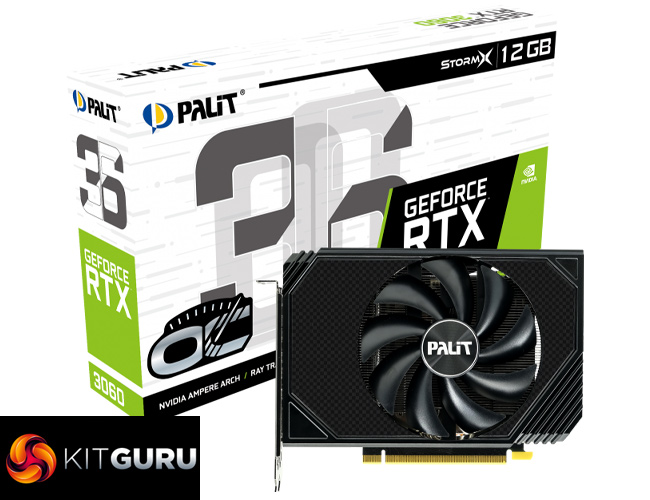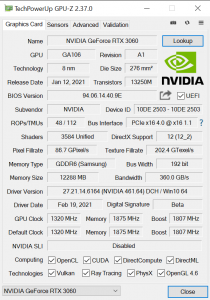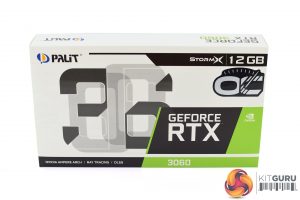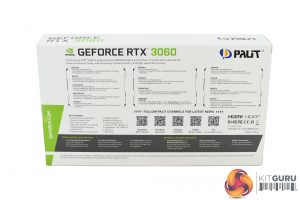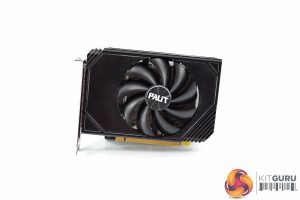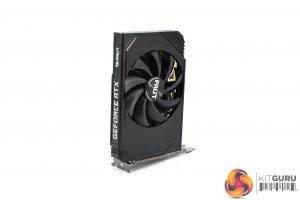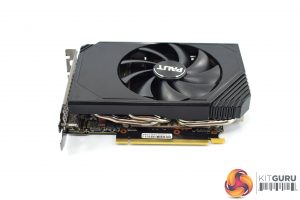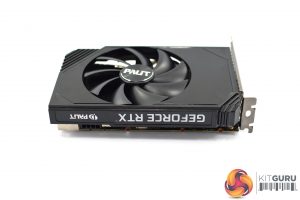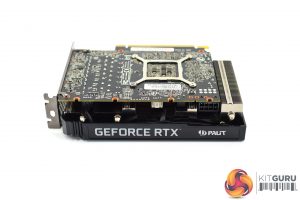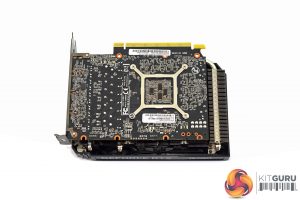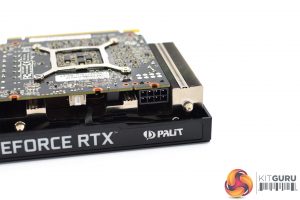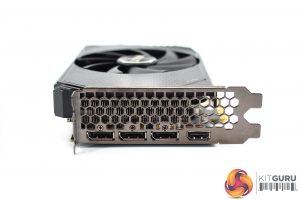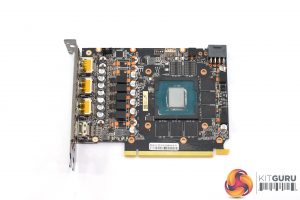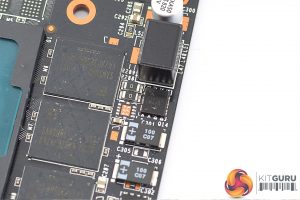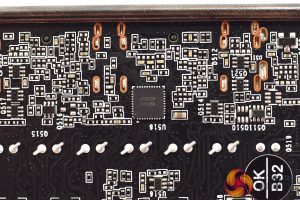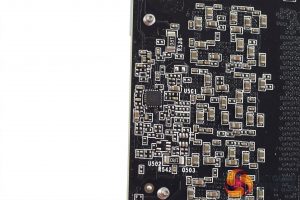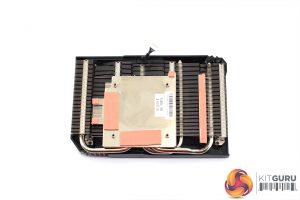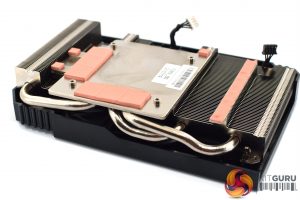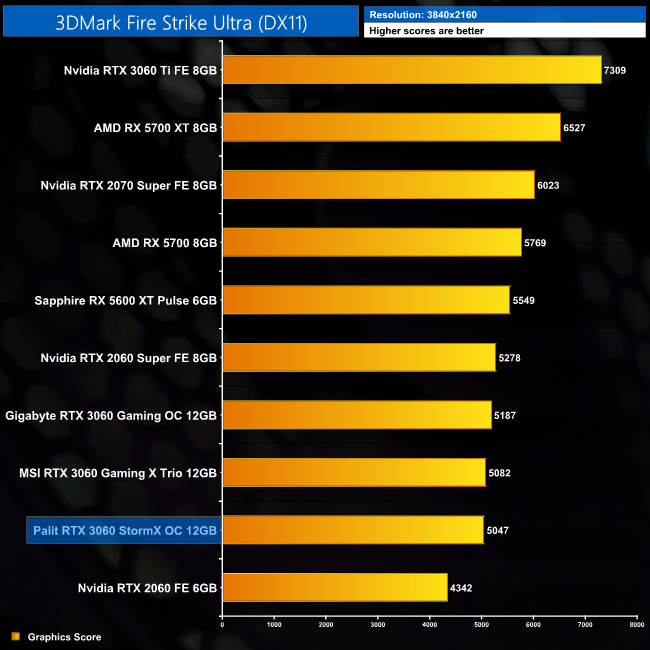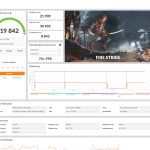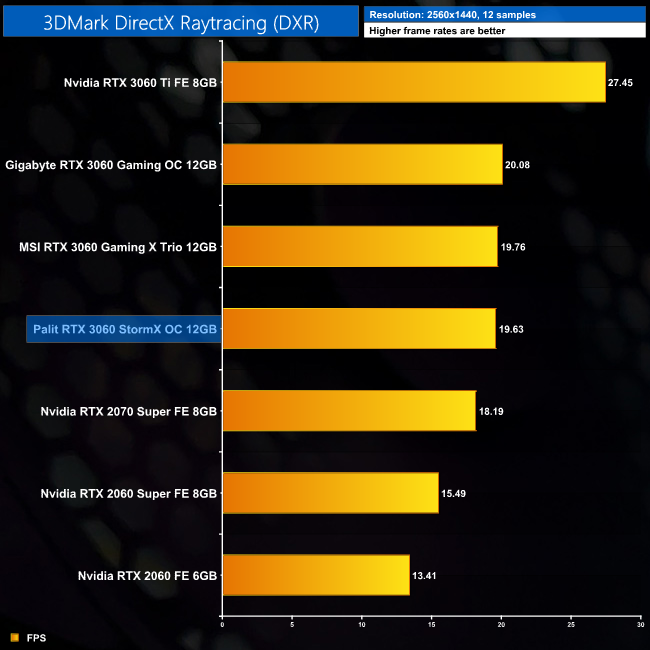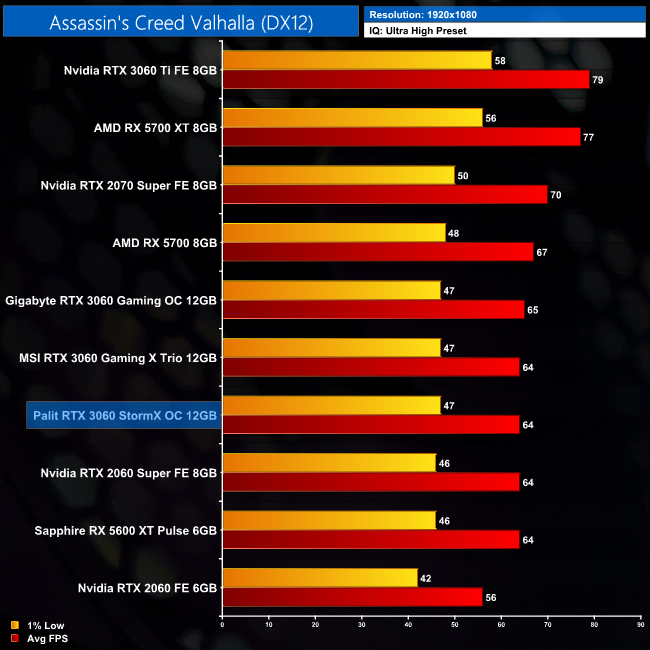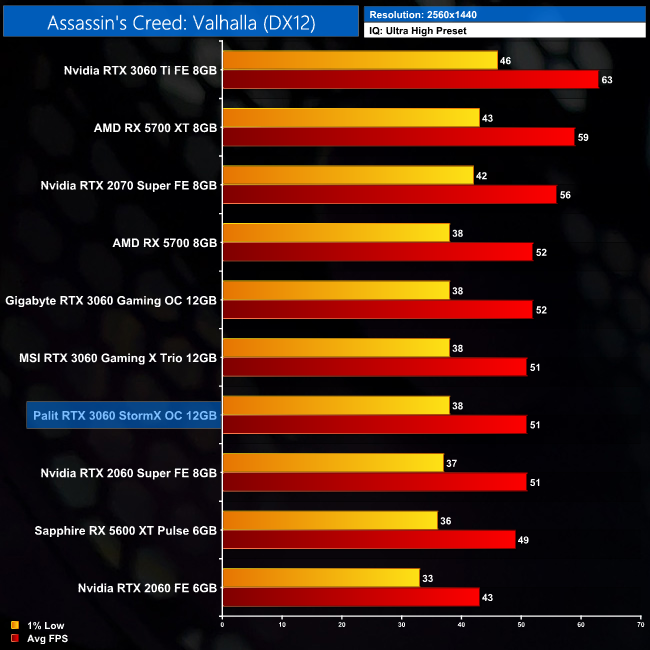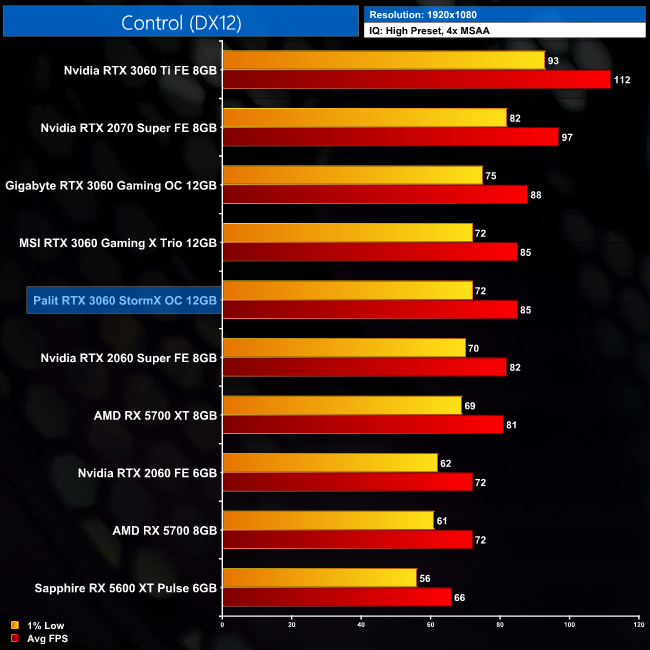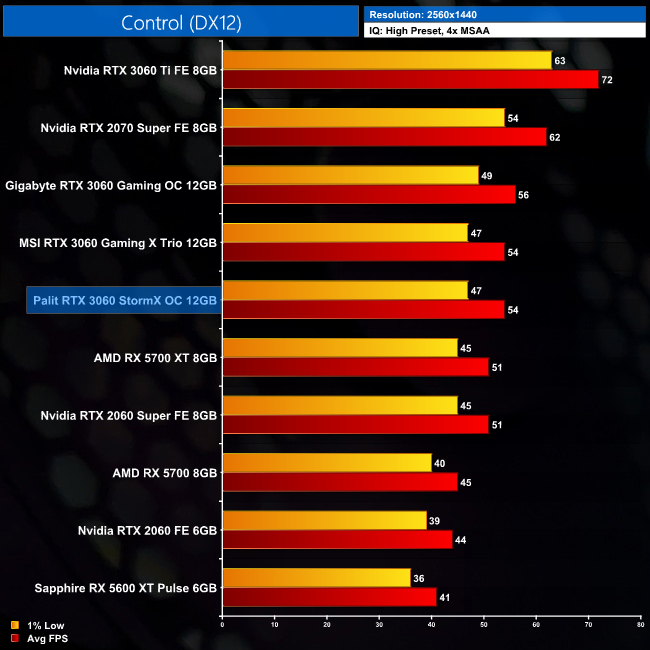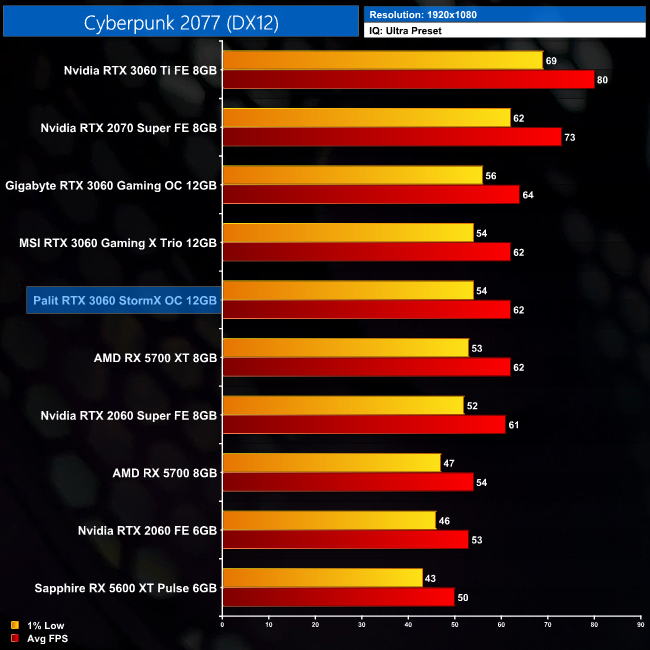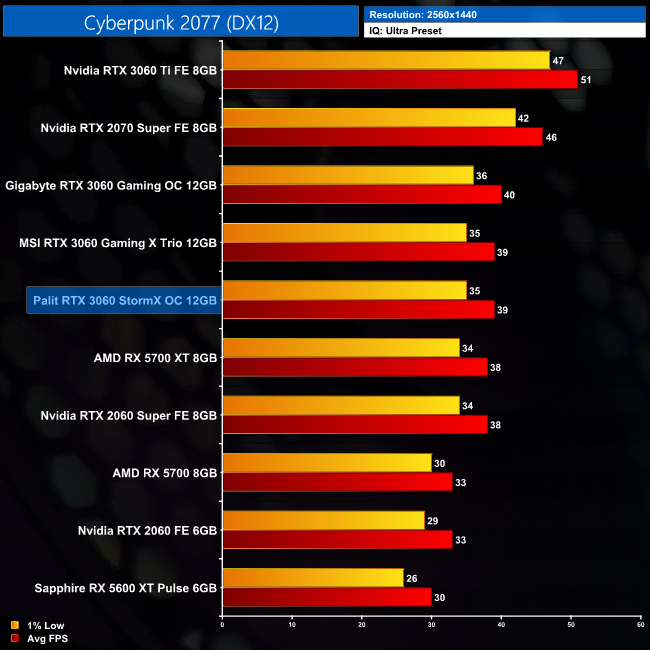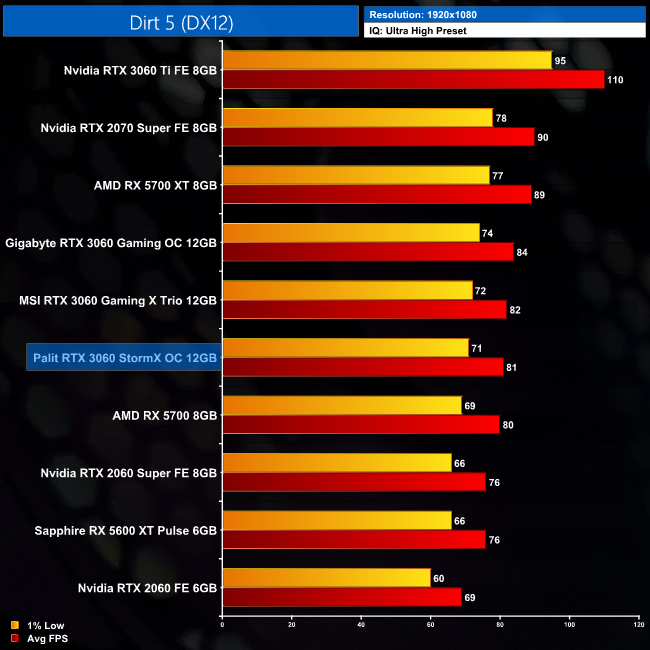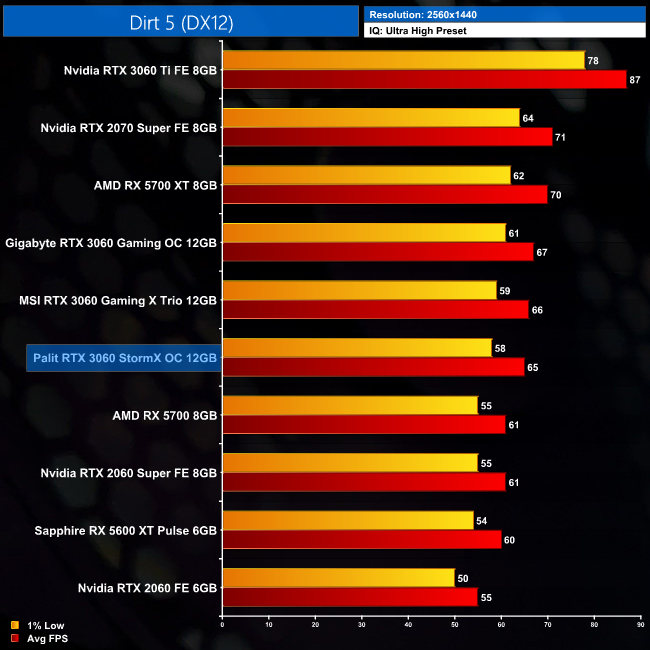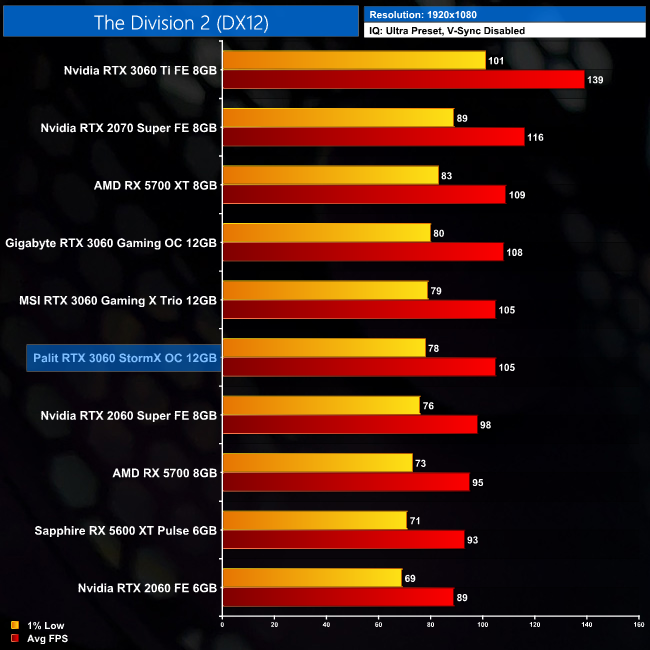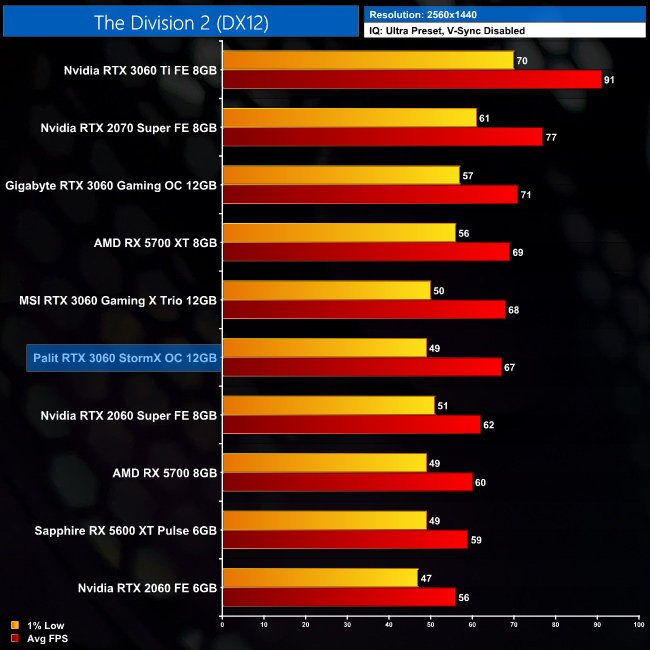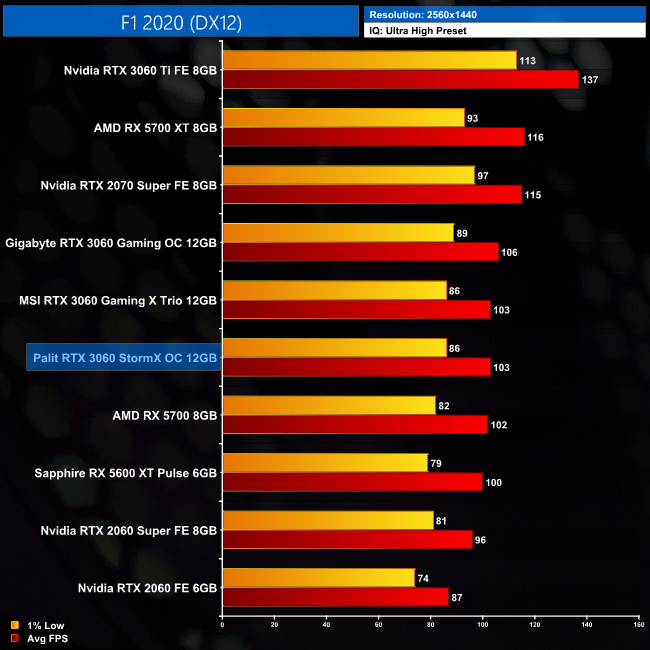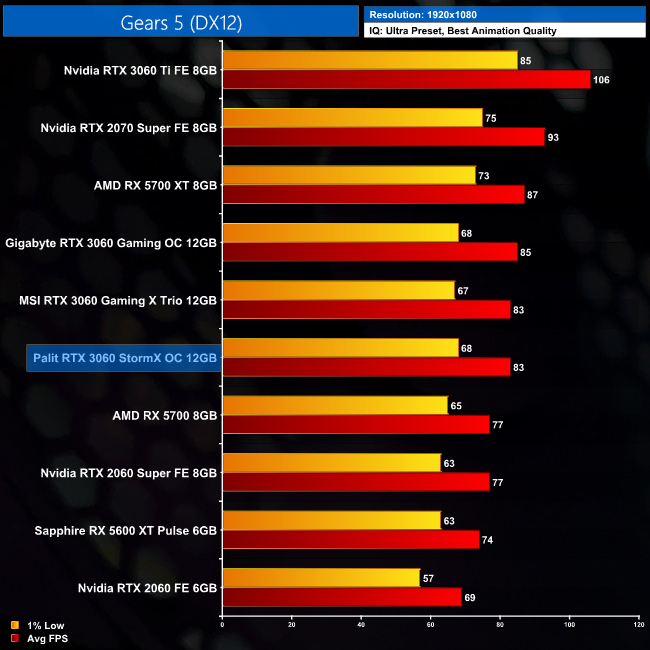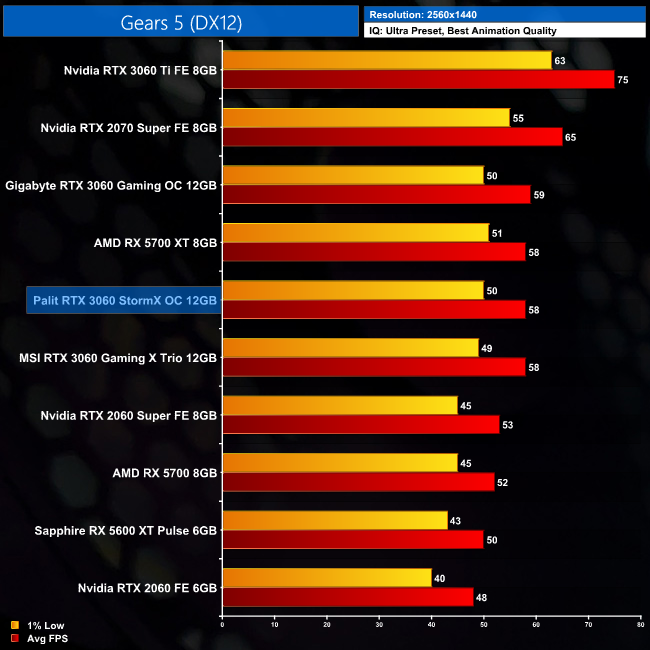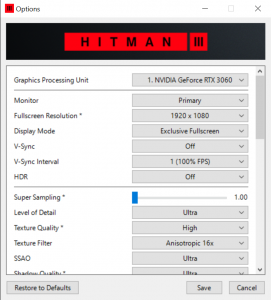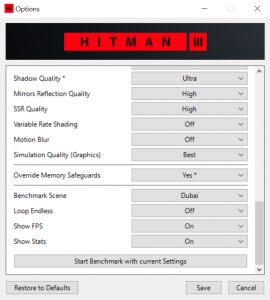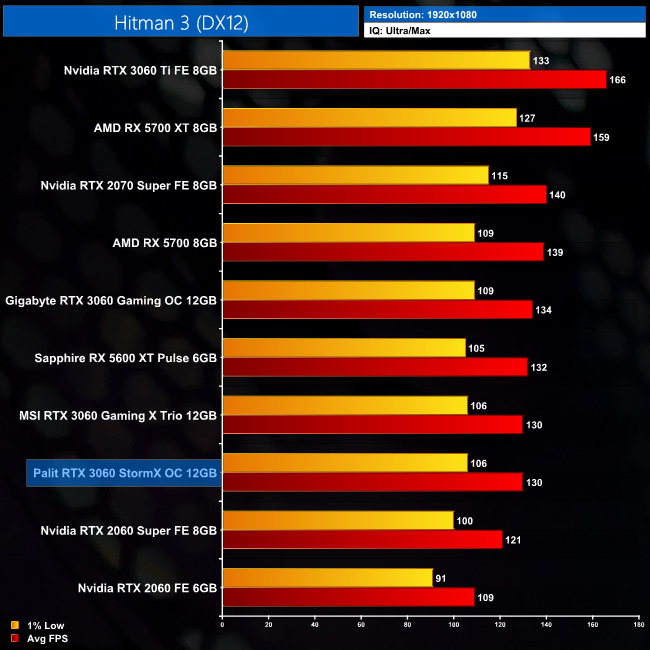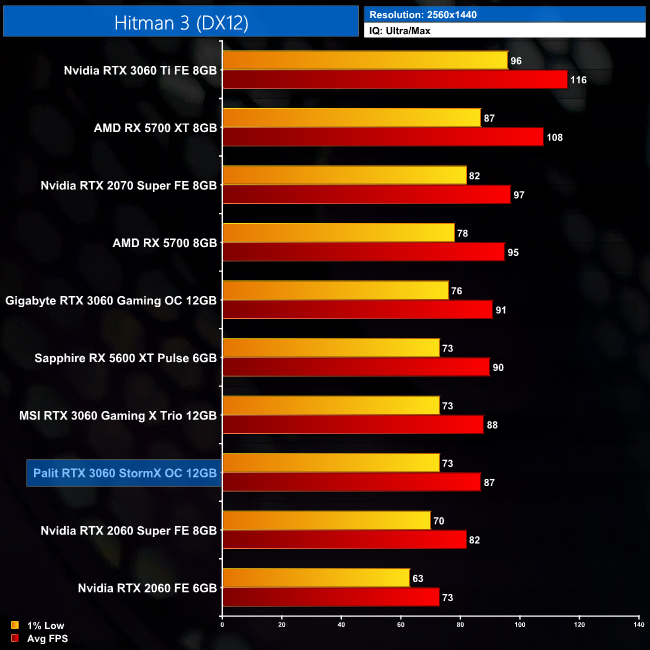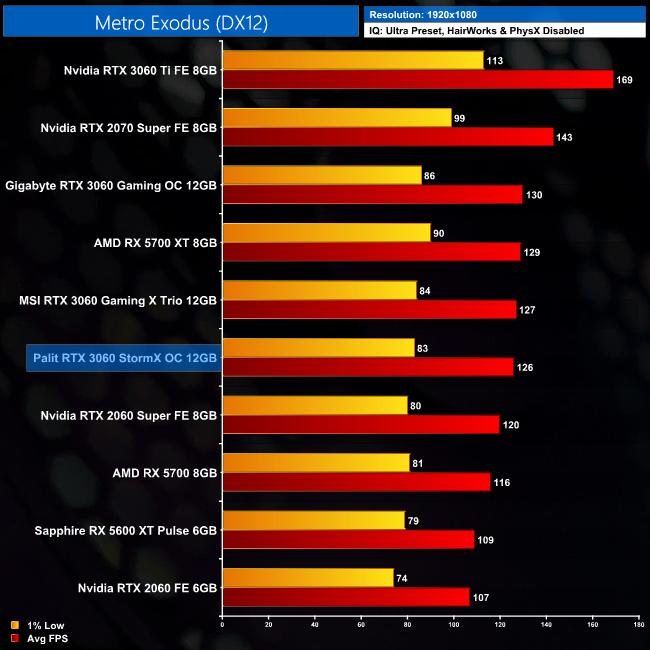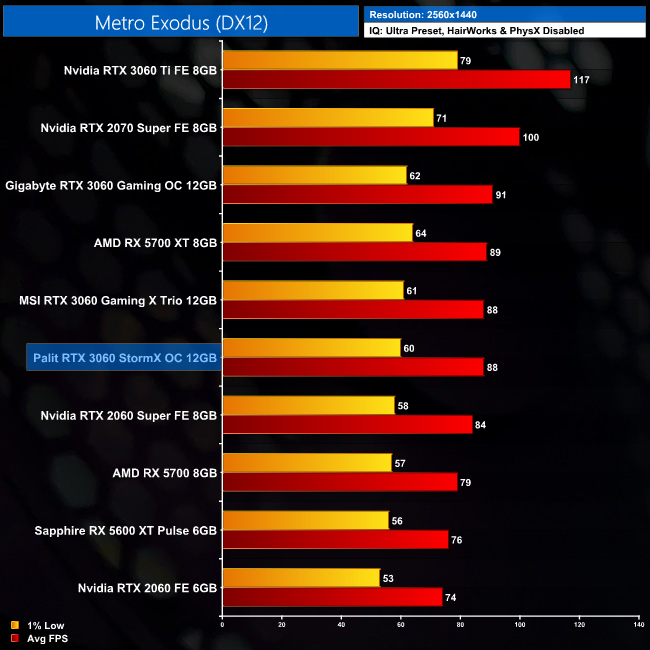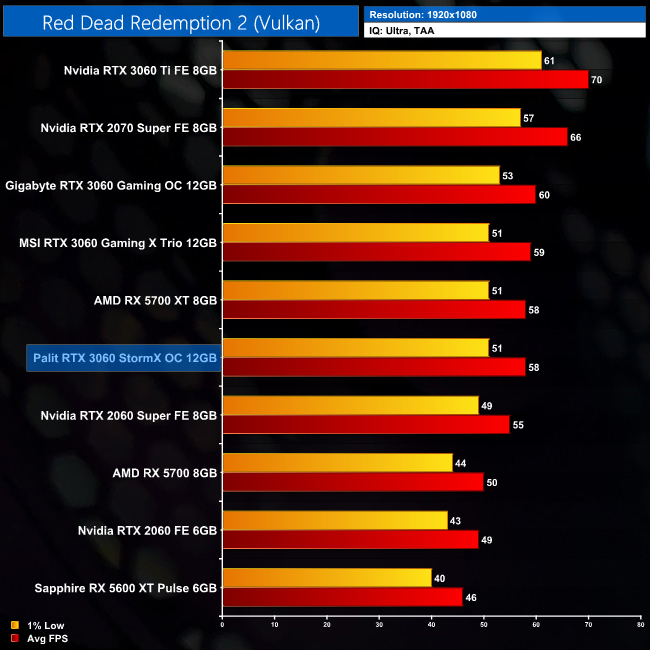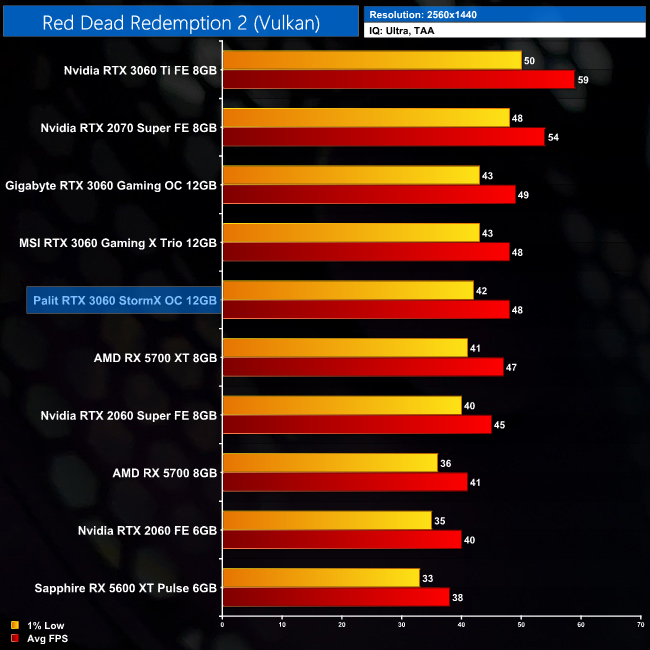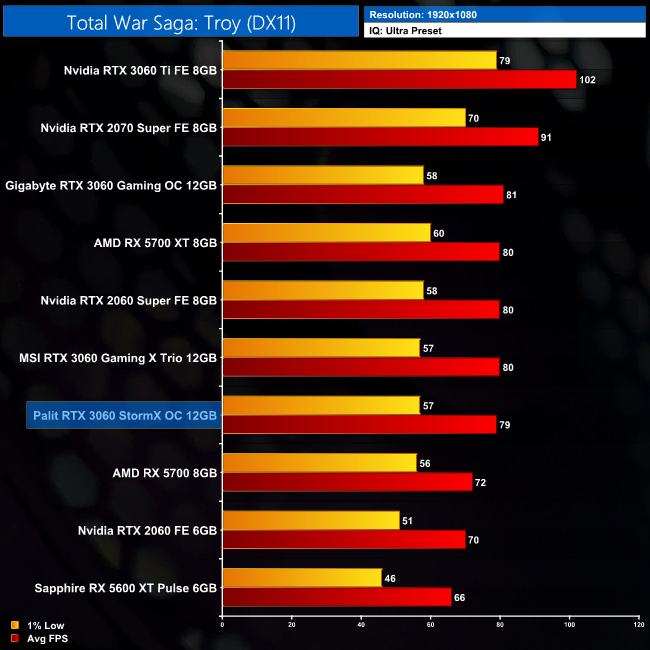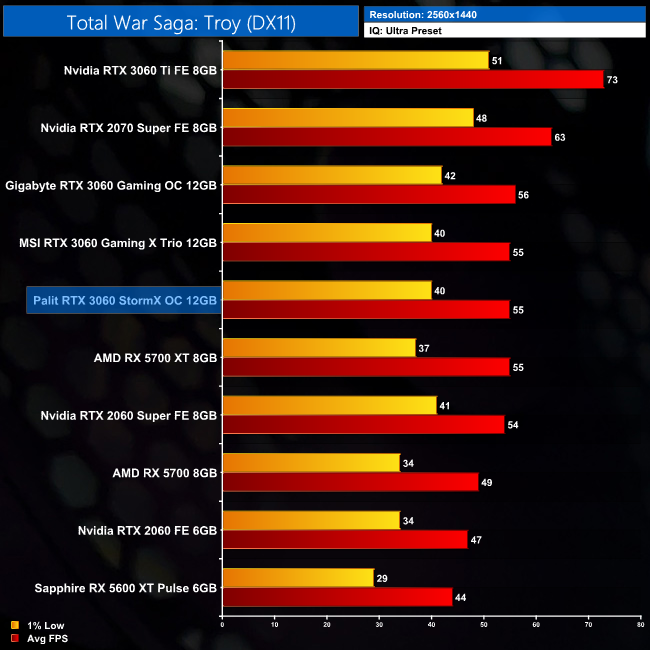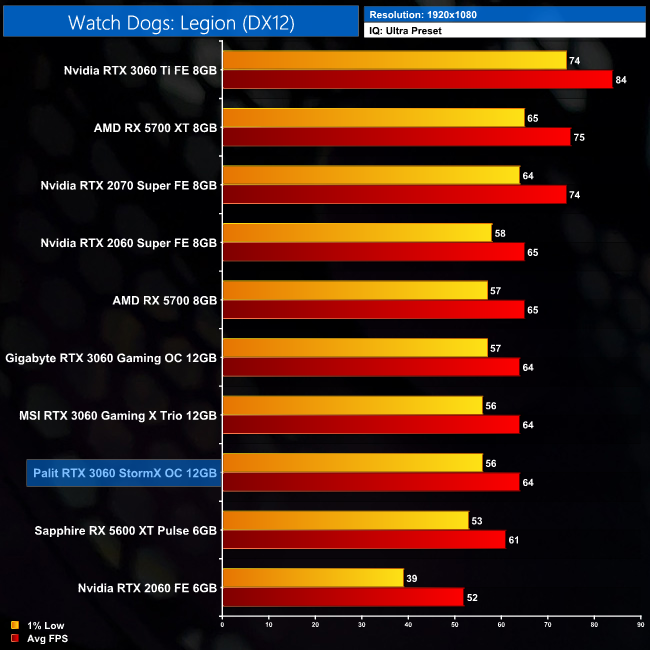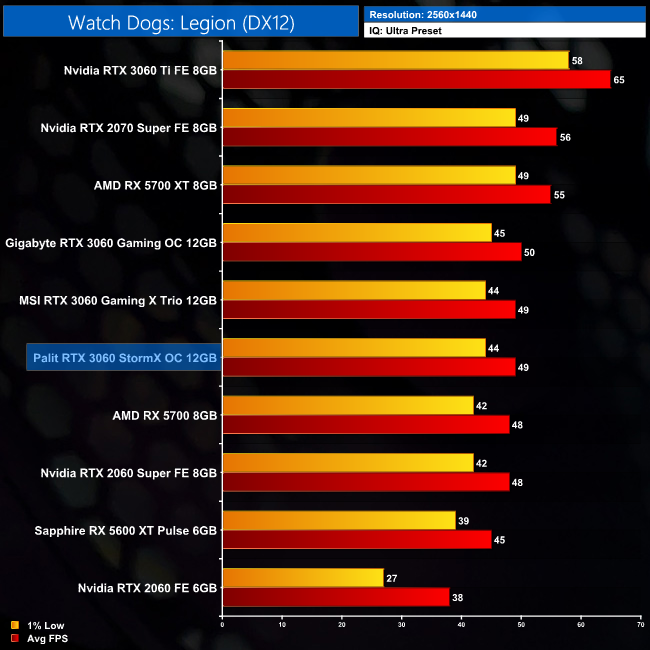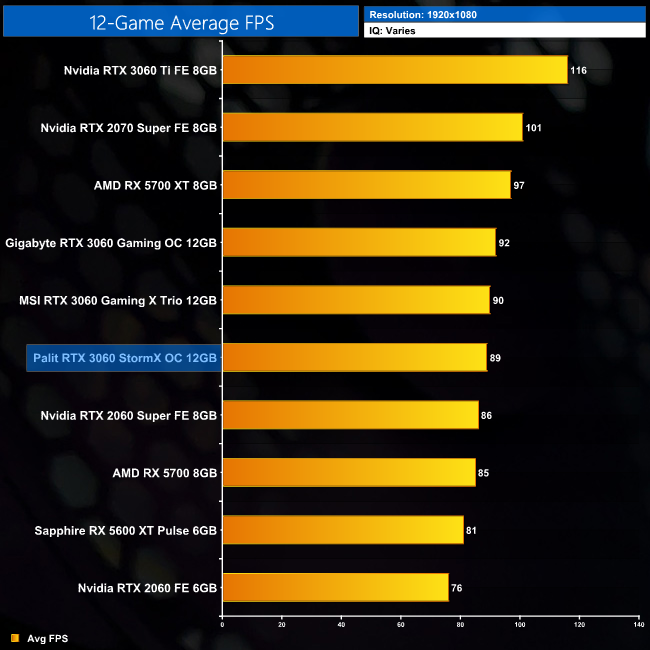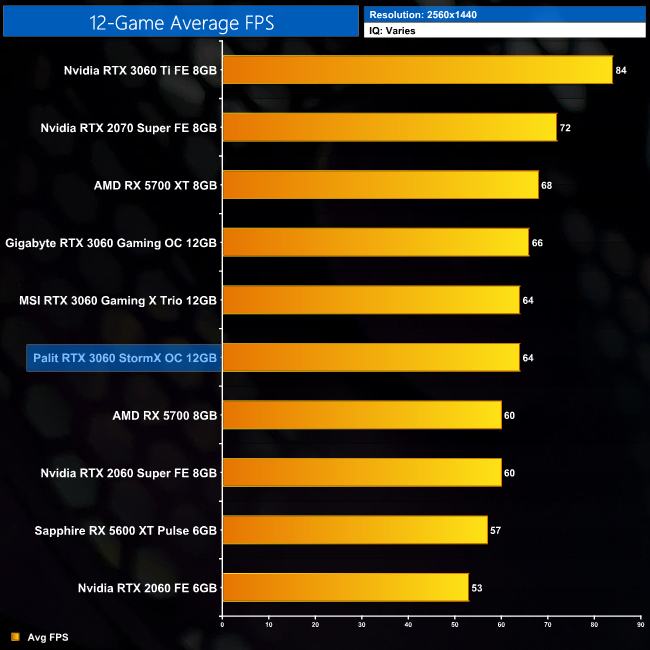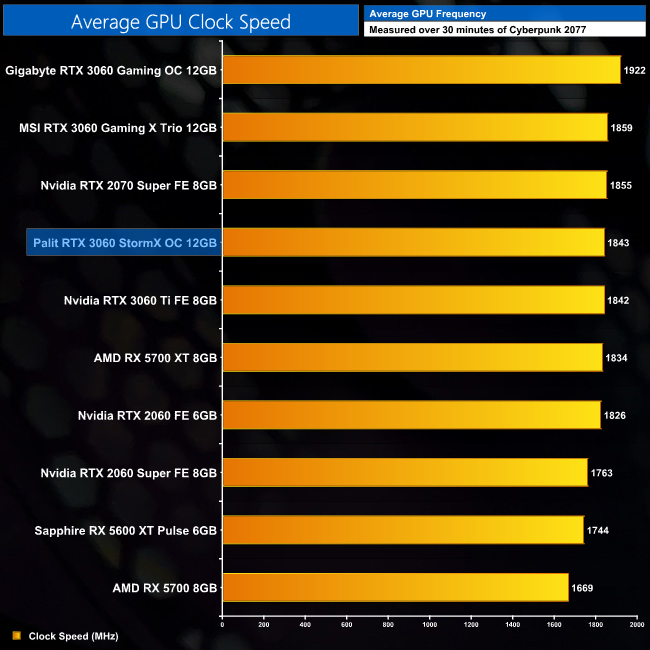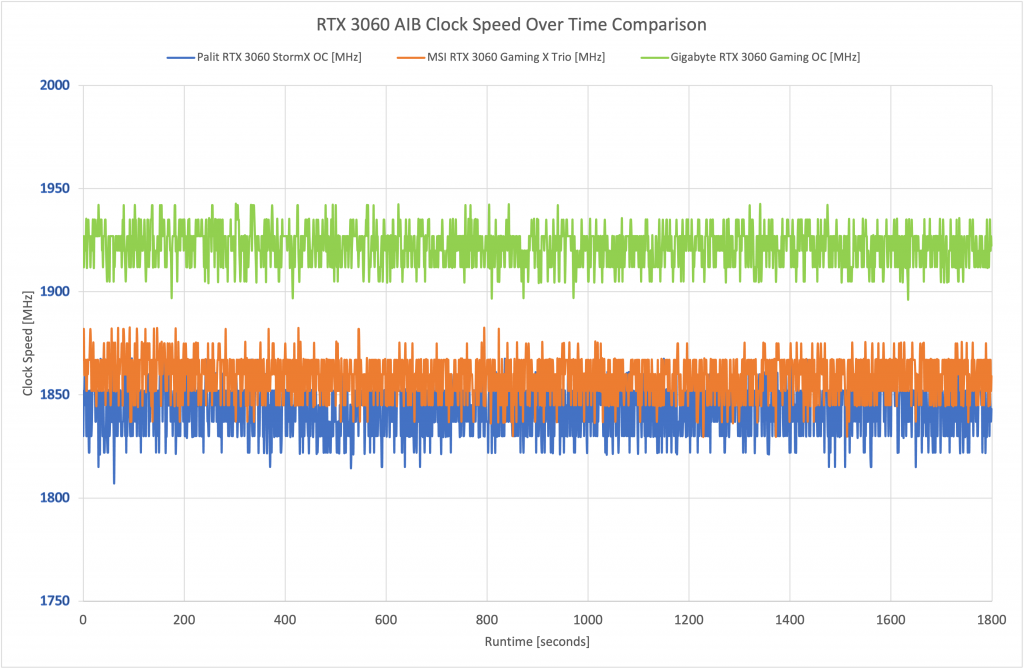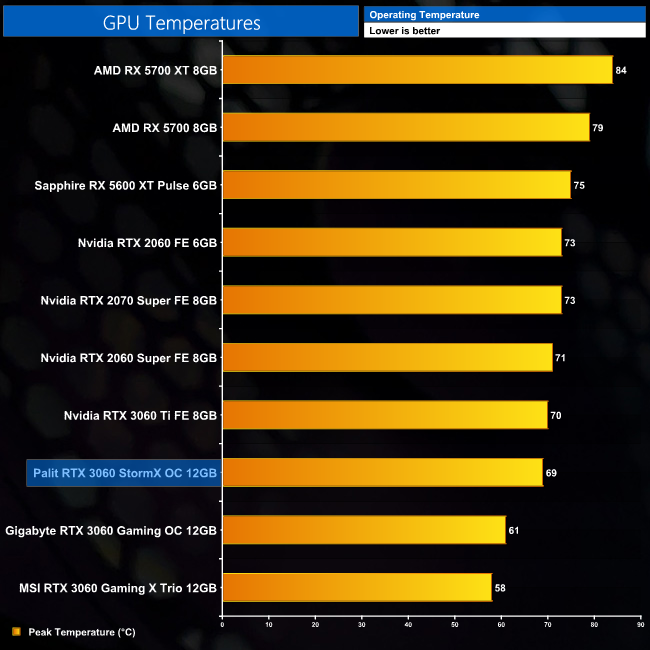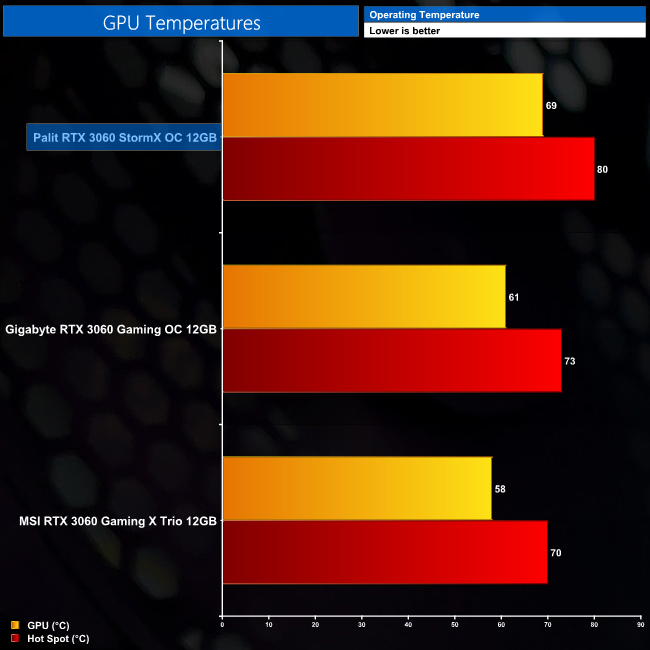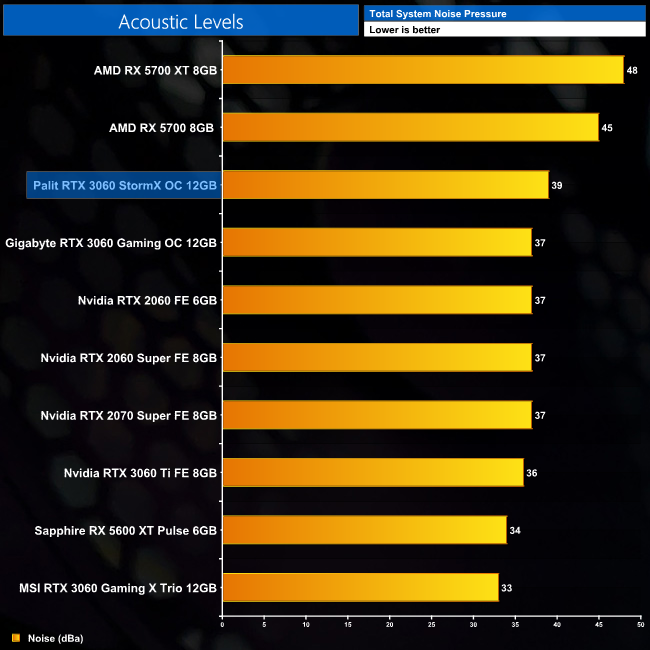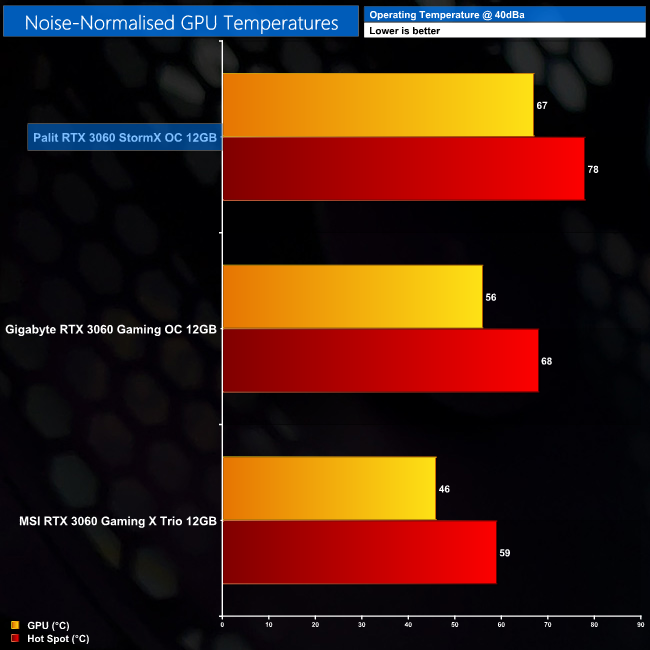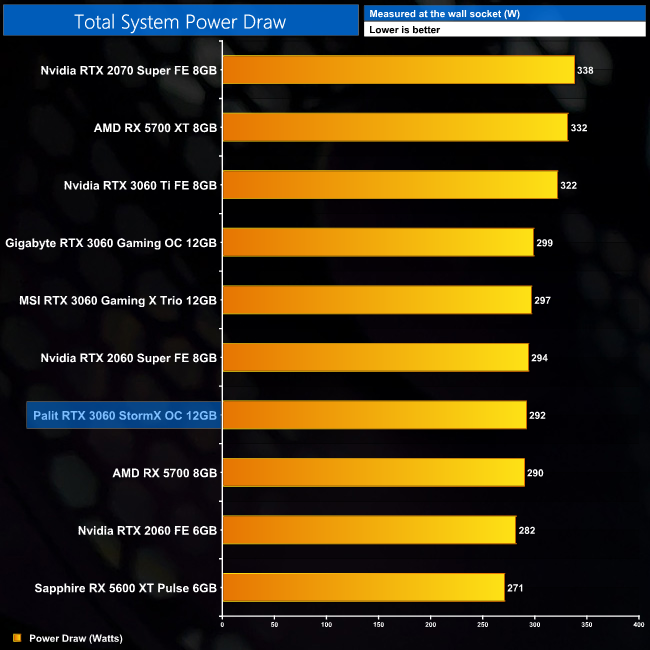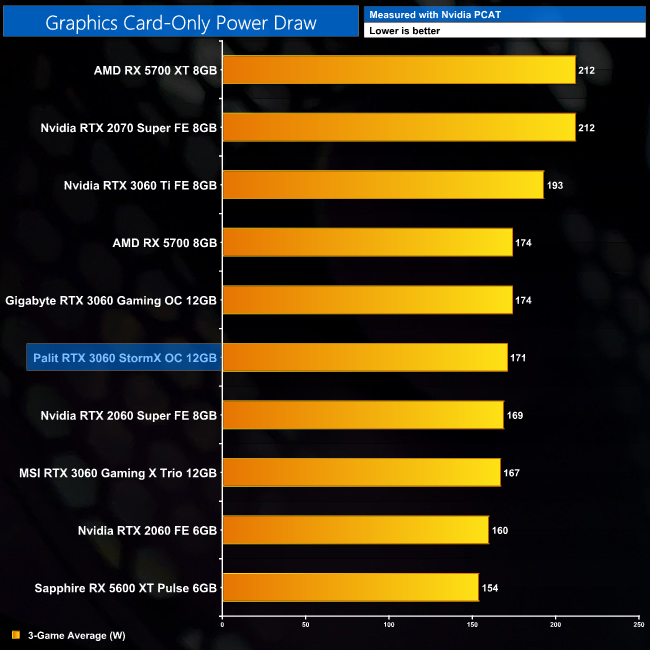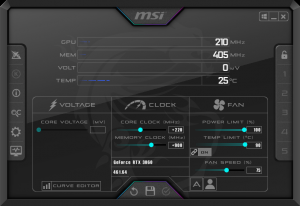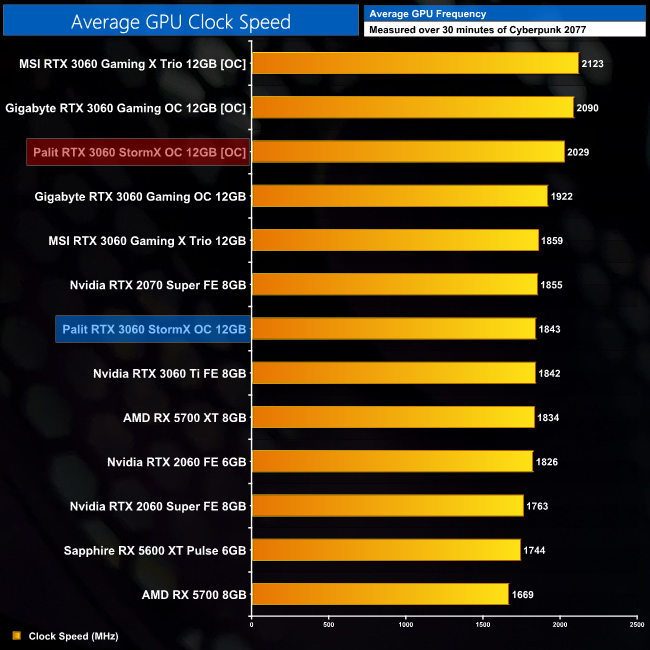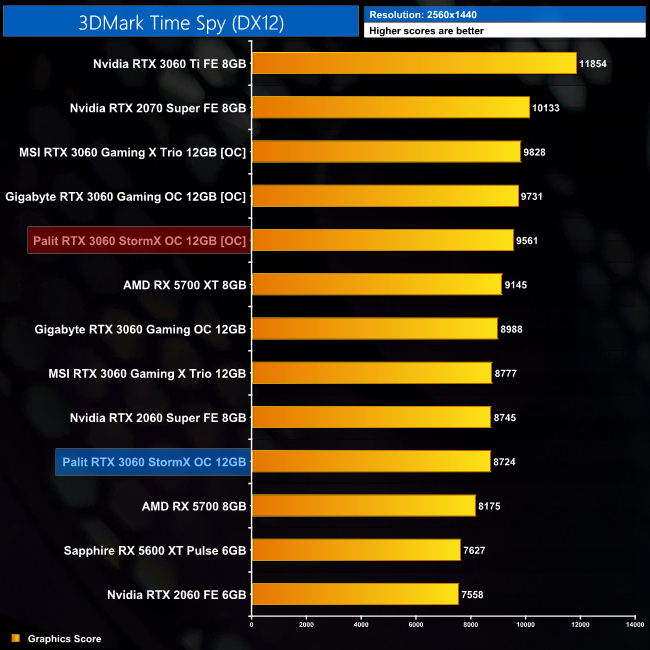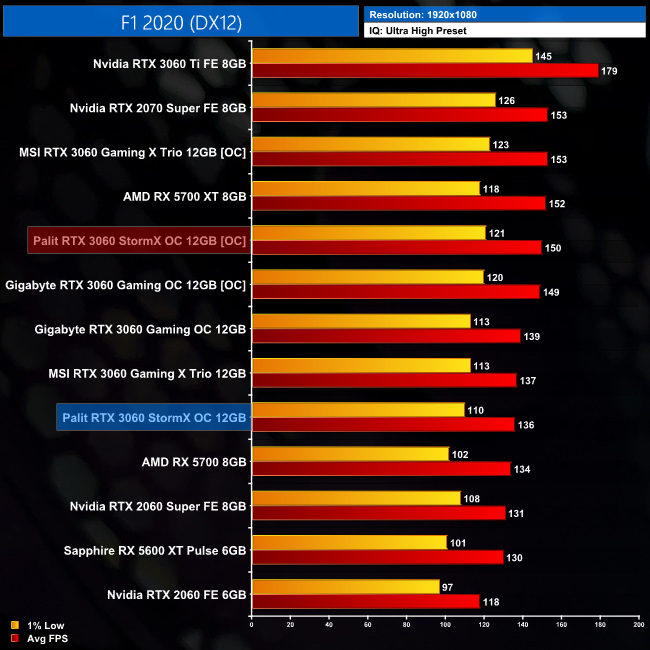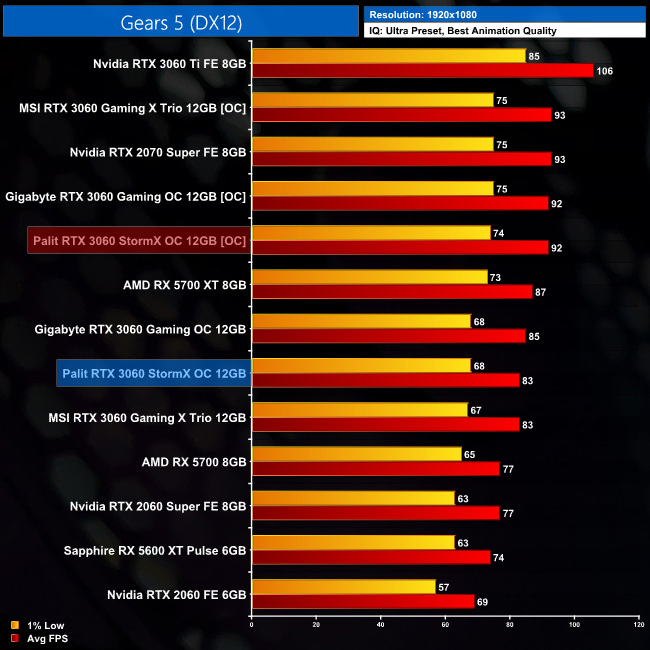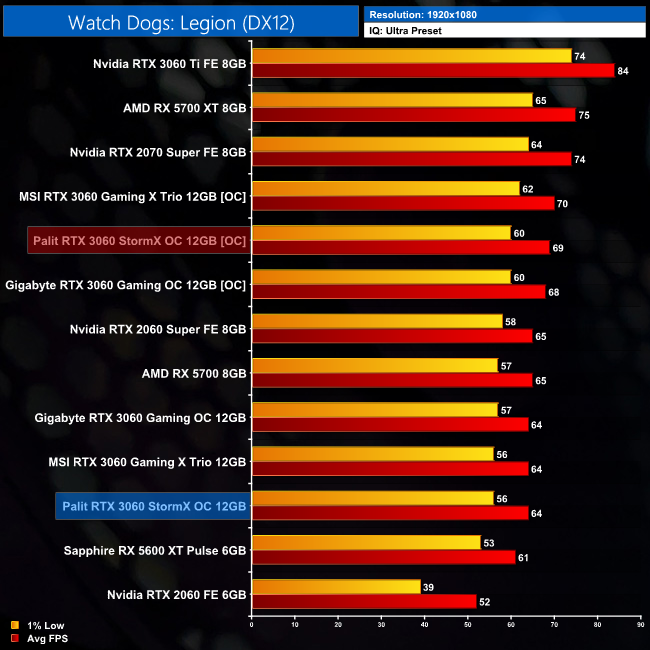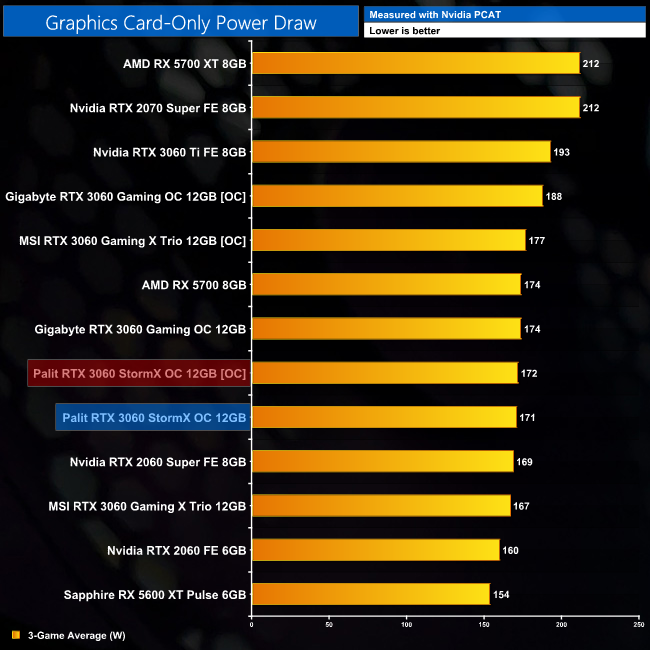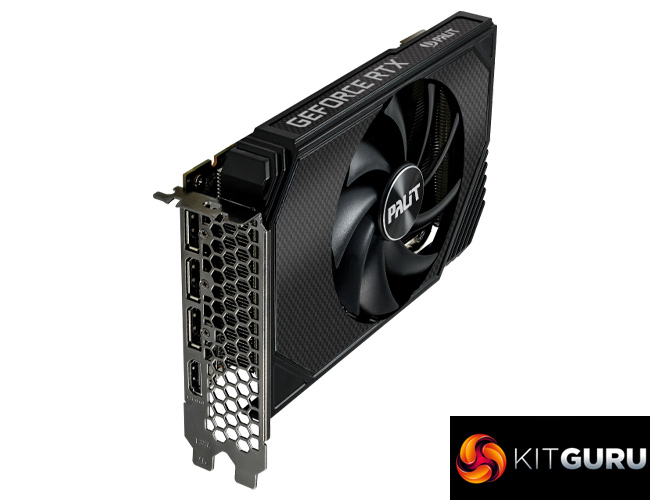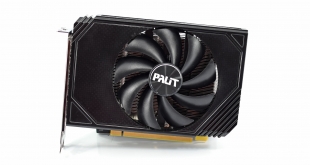
Since the launch of Nvidia's Ampere architecture last year, we have seen a number of GPUs hit the market with very high TDPs, perfectly illustrated by RTX 3080 and RTX 3090 which both consume over 300W of power. This meant board partners had to design some seriously large coolers to deal with such high-power silicon. With the RTX 3060, however, we are starting to see a shift in thinking. With its 170W TDP, Palit has been able to design a single-fan card that is barely longer than a x16 PCIe slot.
To start with an interesting fact, since the launch of the RTX 30-series last September, I've not reviewed a single graphics card from one of Nvidia's board partners that wasn't a triple-fan card. There's nothing inherently wrong with such cards, but more fans of course means more space required, so the coolers from the likes of ASUS, MSI and Gigabyte have all been pretty large.
Not so for the Palit RTX 3060 StormX OC. This card measures just 170mm long, utilising a single 100mm fan, while its heatsink design is also fairly basic. Is this card good enough to handle the 170W GA106 GPU? That's what we will find out today.
| GPU | RTX 3090 | RTX 3080 | RTX 3070 | RTX 3060 Ti | RTX 3060 |
| SMs | 82 | 68 | 46 | 38 | 28 |
| CUDA Cores | 10496 | 8704 | 5888 | 4864 | 3584 |
| Tensor Cores | 328 | 272 | 184 | 152 | 112 |
| RT Cores | 82 | 68 | 46 | 38 | 28 |
| Texture Units | 328 | 272 | 184 | 152 | 112 |
| ROPs | 112 | 96 | 96 | 80 | 48 |
| GPU Boost Clock | 1695 MHz | 1710 MHz | 1725 MHz | 1665 MHz | 1777 MHz |
| Memory Data Rate | 19.5 Gbps | 19 Gbps | 14 Gbps | 14 Gbps | 15 Gbps |
| Total Video Memory | 24GB GDDR6X | 10GB GDDR6X | 8GB GDDR6 | 8GB GDDR6 | 12GB GDDR6 |
| Memory Interface | 384-bit | 320-bit | 256-bit | 256-bit | 192-bit |
| Memory Bandwidth | 936 GB/Sec | 760 GB/Sec | 448 GB/Sec | 448 GB/Sec | 360 GB/sec |
| TGP | 350W | 320W | 220W | 200W | 170W |
Despite utilising new GA106 silicon, RTX 3060 isn't actually a full implementation of the GPU, as it has 28 streaming multiprocessors (SMs) instead of 30. Currently only RTX 3060 for laptops uses the full GPU. For the desktop chip, 28 SMs means a total of 3584 CUDA Cores, as thanks to Ampere’s new SM structure with its two FP32 datapaths, each SM houses 128 CUDA cores.
Ampere also places one RT core, and four Tensor cores, in each SM, giving a total of 28 RT cores and 112 Tensor cores. This is accompanied by 112 texture units, and 48 ROPs which are now housed directly within each graphics processing cluster (GPC), with 16 ROPs per GPC, and 3 GPCs in total for RTX 3060.
Interestingly, rated clock speed is the highest it has been for an Ampere GPU, coming in at 1777MHz for the reference spec. This Palit StormX OC model however, has increased this to 1807MHz, and we test real-world clock speed behaviour later in this review.
There's been a lot of talk about Nvidia's decision to use 12GB GDDR6 memory for the RTX 3060. This is more than the RTX 3060 Ti, RTX 3070 and even RTX 3080, but crucially the memory interface is much narrower at 192-bit. With memory clocked at 15Gbps, total memory bandwidth comes in at 360GB/s, about 20% lower than the RTX 3060 Ti.
Lastly, for total graphics power, Nvidia rates the RTX 3060 for 170W, which is 30W less than the RTX 3060 Ti. Despite being factory overclocked, the StormX OC also shares this TGP rating.
The Palit RTX 3060 StormX OC ships in a compact white box. Key features and specifications of the GPU are listed on the back.
The only included accessory is a small user manual.
Now, as for the card itself, it's clearly a very basic design. Palit is using a black plastic shroud, with a semi-gloss finish, so while it is certainly very colour-neutral, it's hardly an eye catching graphics card. Whether or not you care about that though is entirely up to you.
There's just one fan used as part of the cooling solution, featuring 9 fan blades and a diameter of 100mm.
The dimensions are what this card is all about though, and it is impressively small – measuring 170 x 125 x 39mm. In fact, it's barely any longer than the x16 PCIe connector, making this a prime candidate for use in a HTPC or any other ITX build you might be planning.
We can also see there's no backplate, and instead the rear of the PCB is left bare, with the mounting bracket for the cooler clearly visible.
Power requirements and display outputs are completely as expected – the StormX OC requires a single 8-pin connector, while we get 3x DisplayPort 1.4 and 1x HDMI 2.1 ports.
As for the PCB, Palit has gone for as small a design as possible – we can clearly see the PCB ends in line with the PCIe retention clip. I certainly don't believe I have seen a PCB this small before.
In terms of the componentry, Palit has equipped the GPU with a 5-phase VRM, using the UPI UP9512R controller and OnSemi's 302045 MOSFETs. The memory VRM is 2-phase, using UPI's UP1666Q controller alongside Sinopower 7342EK MOSFETs.
The heatsink is also fairly basic. It is comprised of a single aluminium finstack, with three 6mm heatpipes. Both the GPU and the memory contact with a central baseplate, while there is an additional plate for the VRM off to the side.
Driver Notes
- All Nvidia GPUs (except RTX 3060) were benchmarked with the 461.40 driver.
- RTX 3060 was benchmarked with the 461.64 driver supplied to press.
- All AMD GPUs were benchmarked with the Adrenalin 21.2.2 driver.
Test System
We test using the a custom built system from PCSpecialist, based on Intel's latest Comet Lake-S platform. You can read more about it over HERE, and configure your own system from PCSpecialist HERE.
| CPU |
Intel Core i9-10900K
Overclocked to 5.1GHz on all cores |
| Motherboard |
ASUS ROG Maximus XII Hero Wi-Fi
|
| Memory |
Corsair Vengeance DDR4 3600MHz (4 X 8GB)
CL 18-22-22-42
|
| Graphics Card |
Varies
|
| System Drive |
500GB Samsung 970 Evo Plus M.2
|
| Games Drive | 2TB Samsung 860 QVO 2.5″ SSD |
| Chassis | Fractal Meshify S2 Blackout Tempered Glass |
| CPU Cooler |
Corsair H115i RGB Platinum Hydro Series
|
| Power Supply |
Corsair 1200W HX Series Modular 80 Plus Platinum
|
| Operating System |
Windows 10 2004
|
Comparison Graphics Cards List
- Nvidia RTX 3060 Ti FE 8GB
- Gigabyte RTX 3060 Gaming OC 12GB
- MSI RTX 3060 Gaming X Trio 12GB
- Nvidia RTX 2070 Super FE 8GB
- Nvidia RTX 2060 Super FE 8GB
- Nvidia RTX 2060 FE 6GB
- AMD RX 5700 XT 8GB
- AMD RX 5700 8GB
- Sapphire RX 5600 XT Pulse 6GB
Software and Games List
- 3DMark Fire Strike & Fire Strike Ultra (DX11 Synthetic)
- 3DMark Time Spy (DX12 Synthetic)
- 3DMark Raytracing Feature Test (DXR Synthetic)
- Assassin's Creed Valhalla (DX12)
- Control (DX12)
- Cyberpunk 2077 (DX12)
- Dirt 5 (DX12)
- The Division 2 (DX12)
- F1 2020 (DX12)
- Gears 5 (DX12)
- Hitman 3 (DX12)
- Metro: Exodus (DX12)
- Red Dead Redemption 2 (Vulkan)
- Total War Saga: Troy (DX11)
- Watch Dogs: Legion (DX12)
We run each benchmark/game three times, and present mean averages in our graphs. We use OCAT to measure average frame rates as well as 1% low values across our three runs.
Fire Strike is a showcase DirectX 11 benchmark for modern gaming PCs. Its ambitious real-time graphics are rendered with detail and complexity far beyond other DirectX 11 benchmarks and games. Fire Strike includes two graphics tests, a physics test and a combined test that stresses the CPU and GPU. (UL).
3DMark Time Spy is a DirectX 12 benchmark test for Windows 10 gaming PCs. Time Spy is one of the first DirectX 12 apps to be built the right way from the ground up to fully realize the performance gains that the new API offers. With its pure DirectX 12 engine, which supports new API features like asynchronous compute, explicit multi-adapter, and multi-threading, Time Spy is the ideal test for benchmarking the latest graphics cards. (UL).
Kicking off with our 3DMark benchmarks, here we can see the Palit scores the lowest of the three RTX 3060s we have tested so far. It's hardly a big difference, but it's 2-3% behind the Gigabyte Gaming OC model we reviewed for launch day.
Real-time ray tracing is incredibly demanding. The latest graphics cards have dedicated hardware that’s optimized for ray-tracing. The 3DMark DirectX Raytracing feature test measures the performance of this dedicated hardware. Instead of using traditional rendering techniques, the whole scene is ray-traced and drawn in one pass. The result of the test depends entirely on ray-tracing performance. (UL).
In terms of the DXR featuretest, the StormX OC averages just below 20FPS, putting it 2% behind the Gigabyte Gaming OC.
Assassin's Creed Valhalla is an action role-playing video game developed by Ubisoft Montreal and published by Ubisoft. It is the twelfth major installment and the twenty-second release in the Assassin's Creed series, and a successor to the 2018's Assassin's Creed Odyssey. The game was released on November 10, 2020, for Microsoft Windows, PlayStation 4, Xbox One, Xbox Series X and Series S, and Stadia, while the PlayStation 5 version was released on November 12. (Wikipedia.)
Engine: AnvilNext 2.0. We test using the Ultra High preset, DX12 API.
Starting our game benchmarks with Assassin's Creed Valhalla, here all three RTX 3060s we've tested perform within 1FPS of each other. For the StormX OC, we're looking at a 14% performance uplift compared to the RTX 2060.
Control is an action-adventure video game developed by Remedy Entertainment and published by 505 Games. Control was released on 27 August 2019 for Microsoft Windows, PlayStation 4, and Xbox One. (Wikipedia).
Engine: Northlight Engine. We test using the High preset, with 4x MSAA, DX12 API.
Next we have Control, and here the StormX OC is faster than the RX 5700 XT by 4FPS, but do remember this is an Nvidia-sponsored title. Against the RTX 2060, we're looking at an 18% gen-on-gen boost here.
Cyberpunk 2077 is a 2020 action role-playing video game developed and published by CD Projekt. The story takes place in Night City, an open world set in the Cyberpunk universe. Players assume the first-person perspective of a customisable mercenary known as V, who can acquire skills in hacking and machinery with options for melee and ranged combat. Cyberpunk 2077 was released for Microsoft Windows, PlayStation 4, Stadia, and Xbox One on 10 December 2020. (Wikipedia)
Engine: REDengine 4. We test using the Ultra preset, DX12 API.
Cyberpunk 2077 is another Nvidia-sponsored title, with Palit's StormX OC matching the RX 5700 XT here. It is, however, 3% slower than the Gigabyte RTX 3060 Gaming OC at 1080p, but that's only a difference of 2FPS, so it is hardly significant.
Dirt 5 (stylised as DIRT5) is a racing video game developed and published by Codemasters. It is the fourteenth game in the Colin McRae Rally series and the eighth game to carry the Dirt title. The game was released for Microsoft Windows, PlayStation 4 and Xbox One on 6 November 2020. (Wikipedia).
Engine: Onrush. We test using the Ultra High preset, DX12 API.
As for Dirt 5, here the StormX OC comes in 9% slower than the RX 5700 XT at 1080p, while it's also the slowest of three RTX 3060. MSI's Gaming X Trio is only 1% faster though, and that is significantly bigger and more expensive.
Tom Clancy's The Division 2 is an online action role-playing video game developed by Massive Entertainment and published by Ubisoft. The sequel to Tom Clancy's The Division (2016), it is set in a near-future Washington, D.C. in the aftermath of a smallpox pandemic, and follows an agent of the Strategic Homeland Division as they try to rebuild the city. (Wikipedia).
Engine: Snowdrop. We test using the Ultra preset, but with V-Sync disabled, DX12 API.
In The Division 2, we see all three RTX 3060s averaging over 100FPS, so that's a very smooth experience at 1080p. The Palit StormX OC is outperforming the previous-gen RTX 2060 by 18% here.
F1 2020 is the official video game of the 2020 Formula 1 and Formula 2 Championships developed and published by Codemasters. It is the thirteenth title in the Formula 1 series developed by the studio and was released on 7 July 2020 for pre-orders of the Michael Schumacher Edition and 10 July 2020 for the Seventy Edition on Microsoft Windows, PlayStation 4, Xbox One. (Wikipedia).
Engine: EGO. We test using the Ultra High preset, DX12 API.
Likewise in F1 2020, even at 1440p the StormX OC averages over 100FPS, and it hits 136FPS when gaming at 1080p. It's still the slowest of the three RTX 3060s here, but the margins are very fine indeed.
Gears 5 is a third-person shooter video game developed by The Coalition and published by Xbox Game Studios for Xbox One, Microsoft Windows and Xbox Series X. It is the fifth installment of the Gears of War series and the sequel to Gears of War 4. The ultimate edition was released on September 6, 2019, while the standard edition of the game was released worldwide on September 10, 2019. (Wikipedia).
Engine: Unreal Engine 4. We test using the Ultra preset, with Best Animation Quality (instead of Auto), VRS disabled, DX12 API.
Gears 5 sees the StormX OC pull away from the RTX 2060 by 20%, averaging 83FPS at 1080p. That's the same exact average frame rate as MSI's Gaming X Trio.
Hitman 3 (stylized as HITMAN III) is a stealth game developed and published by IO Interactive for Microsoft Windows, PlayStation 4, PlayStation 5, Xbox One, Xbox Series X/S, Stadia (under the title Hitman: World of Assassination), and Nintendo Switch on 20 January 2021. It is the eighth main installment in the Hitman series and the final entry in the World of Assassination trilogy, following Hitman (2016) and Hitman 2 (2018). (Wikipedia).
Engine: Glacier. We test using Ultra settings (or High where Ultra is not available), VRS off, DX12 API.
The newest game in our test suite is Hitman 3, which sees the StormX again doing very well at 1080p, averaging 130FPS. Compared to the RTX 2060, it's 19% faster here, and it's also on par with the RTX 3060 Gaming X Trio.
Metro Exodus is a first-person shooter video game developed by 4A Games and published by Deep Silver in 2019. It is the third instalment in the Metro video game series based on Dmitry Glukhovsky's novels, following the events of Metro 2033 and Metro: Last Light. (Wikipedia).
Engine: 4A Engine. We test using the Ultra preset, but with Hairworks and Advanced PhysX turned off, DX12 API.
Metro Exodus is another Nvidia-sponsored title, but the RTX 3060 does still slip just behind the RX 5700 XT, but only by a couple per cent. Gen-on-gen, we're looking at an 18% boost versus the RTX 2060.
Red Dead Redemption 2 is a 2018 action-adventure game developed and published by Rockstar Games. The game is the third entry in the Red Dead series and is a prequel to the 2010 game Red Dead Redemption. Red Dead Redemption 2 was released for the PlayStation 4 and Xbox One in October 2018, and for Microsoft Windows and Stadia in November 2019. (Wikipedia).
Engine: Rockstar Advance Game Engine (RAGE). We test by manually selecting Ultra settings (or High where Ultra is not available), TAA, Vulkan API.
Red Dead Redemption 2 is one of the most demanding games we test, and at 1080p the StormX OC couldn't quite average 60FPS using Ultra settings. It's just 1FPS behind the RTX 3060 Gaming X Trio, however.
Total War Saga: Troy is a 2020 turn-based strategy video game developed by Creative Assembly Sofia and published by Sega. The game was released for Windows on 13 August 2020 as the second installment in the Total War Saga subseries, succeeding Thrones of Britannia (2018). (Wikipedia).
Engine: TW 3 Engine. We test using the Ultra preset, with unlimited video memory enabled, DX11 API.
The latest Total War title sees the Palit StormX OC averaged just under 80FPS, so it's effectively on par with the Gaming X Trio. Relative gains compared to the RTX 2060 are more limited however, at just 13%.
Watch Dogs: Legion is a 2020 action-adventure game published by Ubisoft and developed by its Toronto studio. It is the third instalment in the Watch Dogs series, and the sequel to 2016's Watch Dogs 2. Legion was released on October 29, 2020 for Microsoft Windows, PlayStation 4, Xbox One, and Stadia. (Wikipedia).
Engine: Disrupt. We test using the Ultra preset, DX12 API.
Finally, we test Watch Dogs: Legion. Here all three RTX 3060s average 64FPS as it would appear this title isn't overly sensitive to differences in clock speed. That means we're looking at a 23% boost compared to the RTX 2060.
Here we present frame rate figures for each graphics card, averaged across all 12 games on test today. These figures can disguise significant variations in performance from game to game, but provide a useful overview of the sort of performance you can expect at each resolution tested.
Looking at the big picture overview, for average performance at 1080p the StormX OC managed 89FPS. That means it is just 1% slower than the MSI RTX 3060 Gaming X Trio, but 3% slower than Gigabyte's RTX 3060 Gaming OC. Compared to the RTX 2060, it's 17% faster on average.
Here we present the average clock speed for each graphics card while running Cyberpunk 2077 for 30 minutes. We use GPU-Z to record the GPU core frequency during gameplay. We calculate the average core frequency during the 30 minute run to present here.
The reason for the small difference in overall performance between the three RTX 3060s we have tested comes down to clock speed. The Palit averaged 1843MHz across our 30-minute stress test, making it just 16MHz slower than the Gaming X Trio. That's not much at all, but enough to mean the StormX OC did come in 1% behind the Gaming X Trio in most of the games we tested.
For our temperature testing, we measure the peak GPU core temperature under load. A reading under load comes from running Cyberpunk 2077 for 30 minutes.
As for thermals, the StormX OC runs surprisingly cool. I thought it would run hotter, certainly into the high 70s, but out of the box the GPU peaked at just 69C, while the hot spot hit 80C. Yes, this does make it the hottest-running RTX 3060 we've tested, but it's also by far the smallest, and either way, 69C is still a great result.
We take our noise measurements with the sound meter positioned 1 foot from the graphics card. I measured the noise floor to be 32 dBA, thus anything above this level can be attributed to the graphics cards. The power supply is passive for the entire power output range we tested all graphics cards in, while all CPU and system fans were disabled. A reading under load comes from running Cyberpunk 2077 for 30 minutes.
Default fan behaviour for the single 100mm on the StormX OC sees it spins up to 54%, or 1570rpm, with a noise reading of 39dBa. This certainly isn't nearly as loud as something like the RX 5700, but it was just about audible over our system's case fans while gaming. I still wouldn't class it as a loud card, but is is audible.
Following on from our stock thermal and acoustic testing, here we re-test the operating temperature of the GPU, but with noise levels normalised to 40dBa. This allows us to measure the efficiency of the overall cooling solution as varying noise levels as a result of more aggressive fan curves are no longer a factor.
Fan speed only needed to increase by 130rpm for the StormX OC to hit 40dBa, meaning temperatures didn't really drop down much when we tested noise-normalised thermals. We can see a clear gulf between the StormX OC and both the Gigabyte Gaming OC and MSI Gaming X Trio, but again – those cards are much, much bigger.
We measure system-wide power draw from the wall while running the 3DMark Time Spy stress test for 30 minutes.
We also use Nvidia PCAT to measure power draw of the graphics card only, with readings from both the PCIe slot and the PCIe power cables combined into a single figure. This provides us with significantly more accurate data to work with as it is measuring only the GPU power, and not total system power which is a fundamentally imprecise measurement.
Power draw for the StormX OC hit 171W, so pretty much bang on with its 170W power target. This puts it right between the Gaming OC and the Gaming X Trio, but all three GPUs draw within 7W of each other, so these are hardly significant differences.
When overclocking the StormX OC, we are limited by the power slider which can't go above 100%. We were still able to add 220MHz to the GPU and 900MHz to the memory however.
Still, the lack of any power headroom means the StormX OC can't quite sustain clock speeds at the same level as the Gaming X Trio or Gaming OC. It did average over 2000MHz though, so that's still a 10% boost compared to its out of the box behaviour.
This increased frequency saw performance increases of between 8-10% in the games we re-tested at 1080p. Not bad at all considering power draw didn't increase with it…
… or maybe it did, but we're hardly going to complain about a 1W difference!
Following in the footsteps of both Gigabyte's RTX 3060 Gaming OC and MSI's RTX 3060 Gaming X Trio, today we have assessed Palit's RTX 3060 offering, in the diminutive shape of the RTX 3060 StormX OC.
There's really no other place to start than with the size of this graphics card. Measuring in at just 170mm long, it's barely longer than a x16 PCIe slot and is easily the smallest Ampere-based graphics card I have reviewed since the launch of the RTX 30-series last September.
That alone means the StormX OC will be given attention by the mini-ITX community and anyone planning a small form-factor build. But despite its tiny footprint, the StormX OC is still more than a match for the 170W GA106 GPU. Temperatures, for instance, peaked at just 69C, while the single fan only emitted a touch more noise than something like an Nvidia RTX 3070 Founders Edition.
Of course, its size means it can't match a Gaming X Trio in terms of raw cooling ability, but I'd argue that doesn't really matter. A peak GPU temperature that's below 70C is more than good enough, especially when that's delivered in a package this small.
It's also impressive that the StormX OC runs pretty much as fast as the RTX 3060 Gaming X Trio, too. Averaged across all 12 games we tested, the Palit card is just 1% slower on average, but that difference is absolutely negligible – and even quite impressive considering it's also half the size of the MSI card.
As for pricing, in an ordinary world we'd expect the StormX OC to sit pretty close to Nvidia's MSRP of £299, in which case it would be an excellent option. With the market being what is is, Palit told us the UK MSRP for this card is £399, which is still less than the other RTX 3060s we've reviewed, but clearly much higher than it should be.
Ultimately, if you are looking for an RTX 3060, the Palit RTX 3060 StormX OC is a very impressive card considering just how small it really is. If space is at a premium in your system, this would be well worth a look. We can only hope it comes back into stock at a reasonable price point, but given the current state of affairs, we would imagine that's going to be quite unlikely.
We found the StormX OC listed at CCL HERE, but it is out of stock at the time of writing.
Discuss on our Facebook page HERE.
Pros
- Incredibly small.
- Very solid thermal and acoustic performance considering the size.
- Effectively as fast as MSI's Gaming X Trio, which is almost twice as large.
Cons
- Pretty plain to look at.
- No backplate.
KitGuru says: For a graphics card to be this small, but deliver the results it does, is a very impressive thing. Anyone about to build a new SFF system should definitely take a look at the StormX OC.
 KitGuru KitGuru.net – Tech News | Hardware News | Hardware Reviews | IOS | Mobile | Gaming | Graphics Cards
KitGuru KitGuru.net – Tech News | Hardware News | Hardware Reviews | IOS | Mobile | Gaming | Graphics Cards


